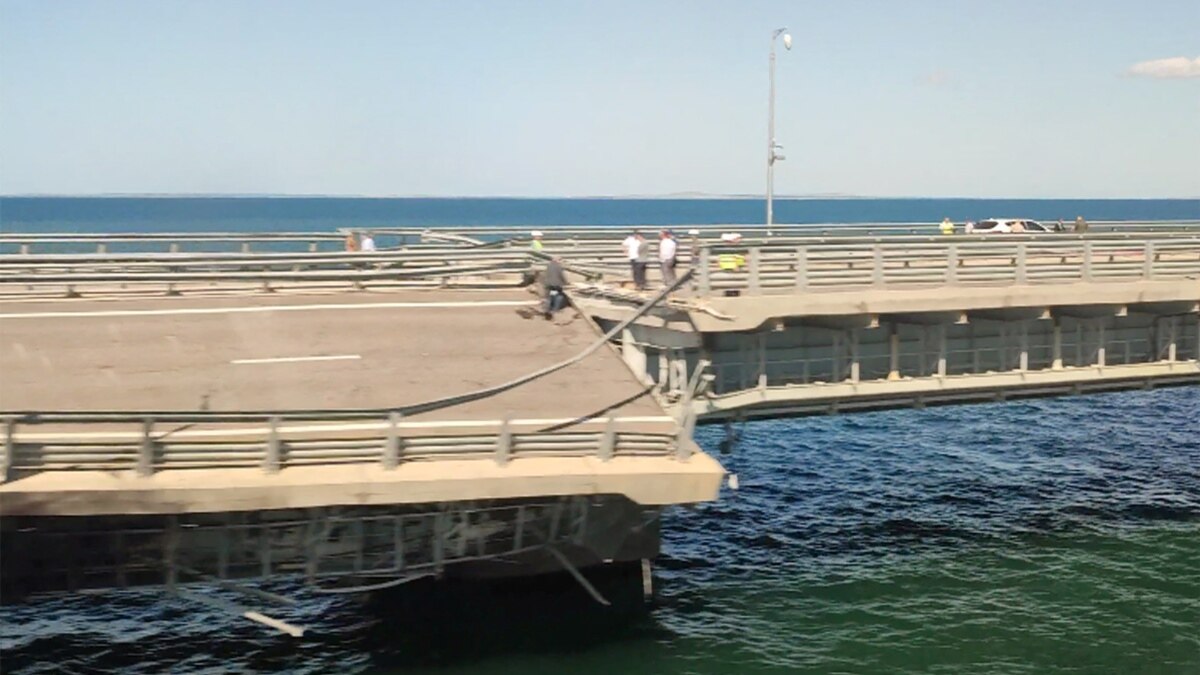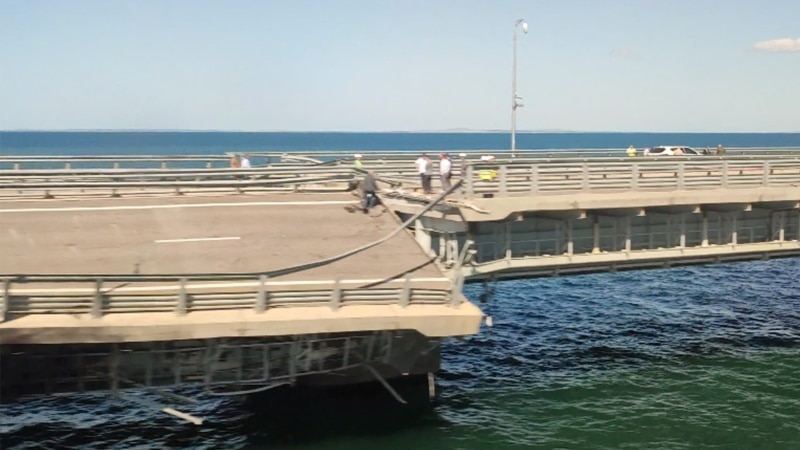Russia Falsely Denies Using Crimean Bridge for Military Purposes

Early on July 17, drones hit the Crimean Bridge [also known as the Kerch Strait Bridge or Kerch Bridge], which links Russia and the Russian-occupied Crimean Peninsula, damaging the bridge and killing two people.
The following day, Russian Deputy Prime Minister Marat Khusnullin said the explosions had destroyed part of the road on the bridge and that the destroyed section would have to be rebuilt.
Ukrainian media, citing sources in the country’s security service, reported the bridge was hit by Ukrainian naval drones armed with explosives.
Russian President Vladimir Putin ordered that the Crimean Bridge be built after Russia annexed Crimea from Ukraine in 2014. The bridge was first targeted last October. The bridge’s two roadways fully reopened in February, and its twin railroad lines resumed normal operations in May.
Russia’s Foreign Ministry claimed in a July 17 statement condemning the attack that the Crimean Bridge was a strictly civilian target:
“The Foreign Ministry strongly condemns the terrorist attack on the Crimean Bridge, which is a purely civilian facility.”
That is false.
Since May 2018, Russia’s military has used the Crimean Bridge to transfer military equipment from Russia to occupied Crimea. After Russia launched a full-scale invasion of Ukraine in February 2022, the bridge became a key transport corridor for transferring combat vehicles, artillery, ammunition, fuel and personnel to the battlefield in Ukraine.
The Russian military’s use of the bridge has been documented in video recordings and by military experts, as well as Ukrainian and Russian officials.
According to Radio Free Europe/Radio Liberty (RFE/RL), a VOA sister organization, Russia has been using the Crimean Bridge for military purposes for more than five years:
“The movements of Russian columns of military vehicles heading to Crimea were recorded by observers after the completion of the construction of the Kerch bridge and the opening of car traffic in 2018. With the launch of the railway connection at the end of 2019, the movement of military columns also became commonplace.”
On February 16, 2022, the Russian Defense Ministry’s YouTube channel published a video showing military equipment, including tanks, infantry fighting vehicles and self-propelled artillery, being transported across the bridge by rail.
The next day, February 17, 2022, the Russian Defense Ministry’s Zvezda TV network reported:
“Military units of the Southern Military District are returning to their permanent deployment points after exercises held at Crimean training grounds. According to the Ministry of Defense of the Russian Federation, another column of military equipment has already crossed the Crimean Bridge after completion of the training. Both railway trains with equipment and automobile convoys returning home cross the Kerch Strait bridge.”
On August 26, 2022, RFE/RL published a video of a column of Russian heavy military equipment, including engineering vehicles, howitzers, tanks, infantry fighting vehicles and trucks, at the entrance to the Crimean Bridge from the Russian side.
On August 27, 2022, RFE/RL published a video of Russian military personnel headed for the occupied regions of southern Ukraine being transported across the Crimean Bridge.
On October 8, 2022, an explosion on the Crimean Bridge caused its two-lane car spans to collapse into the water. A railway tanker car also caught fire and badly damaged the railroad bridge. The blast killed three people.
That same day, Russian State Duma member Yury Afonin said the bridge had been blown up in order to “create problems for the transfer of the Russian army to strengthen the borders” in Ukraine’s occupied Kherson region, and to “create, among other things, logistical problems.”
Also on October 8, 2022, The New York Times cited an anonymous “senior Ukrainian official” who, according to the newspaper, “confirmed that Ukraine’s intelligence services were behind the bombing.”
Still, on October 20, 2022, Ukrainian President Volodymyr Zelenskyy told Canada’s CTV News television channel: “We definitely didn’t order it, as far as I know.”
On July 8, 2023, nine months after the first bombing of the bridge, Ukrainian Deputy Defense Minister Hanna Maliar admitted that Ukraine had targeted the bridge to disrupt Russian supply lines.
Ukrainian government officials have repeatedly called the Crimean Bridge “a logistical route” for the Russian army, and therefore, a legitimate military target for Ukrainian forces.
The Institute for the Study of War, a Washington, D.C.-based think tank, wrote on July 17 that the Crimean Bridge is a critical supply route for Russian forces in southern Ukraine:
“The Kerch Strait Bridge is along one of two ground lines of communication (GLOCs) supporting Russia’s southern force grouping, with the other route passing through occupied Donetsk, Zaporizhzhia, and Kherson oblasts. This sole remaining logistics route is now a single point of failure for the supply of the large numbers of mechanized Russian forces in southern Ukraine needed to resist Ukrainian counteroffensives.”
Also on July 17, Pavel Aksenov, a military observer for the BBC’s Russian Service, describe the Crimean Bridge as being essential for supplying Russian forces in Ukraine:
“The Crimean Bridge is both a critical link in the supply chain for the Russian army in the southern regions of Ukraine, a critical piece of infrastructure, and a symbol of Russia’s annexation of the peninsula.”
That same day, Ukrainian Foreign Minister Dmytro Kuleba stressed that Russia was using the Crimean Bridge for military purposes in Ukraine:
“But the truth is that one broken Russian bridge means fewer broken Ukrainian lives because this bridge is being used to supplement [the] Russian army in the occupied Crimea and in the occupied territories of the south of Ukraine with additional resources.”



